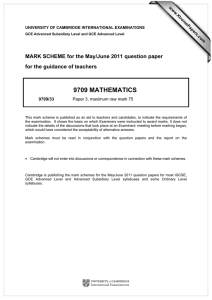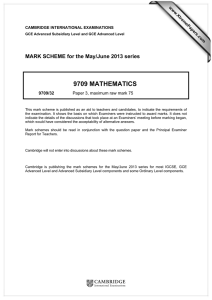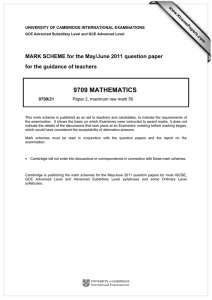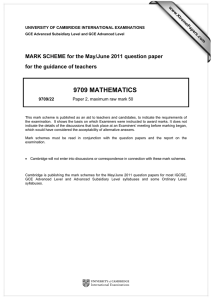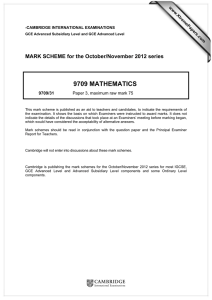9709 MATHEMATICS MARK SCHEME for the May/June 2013 series
advertisement
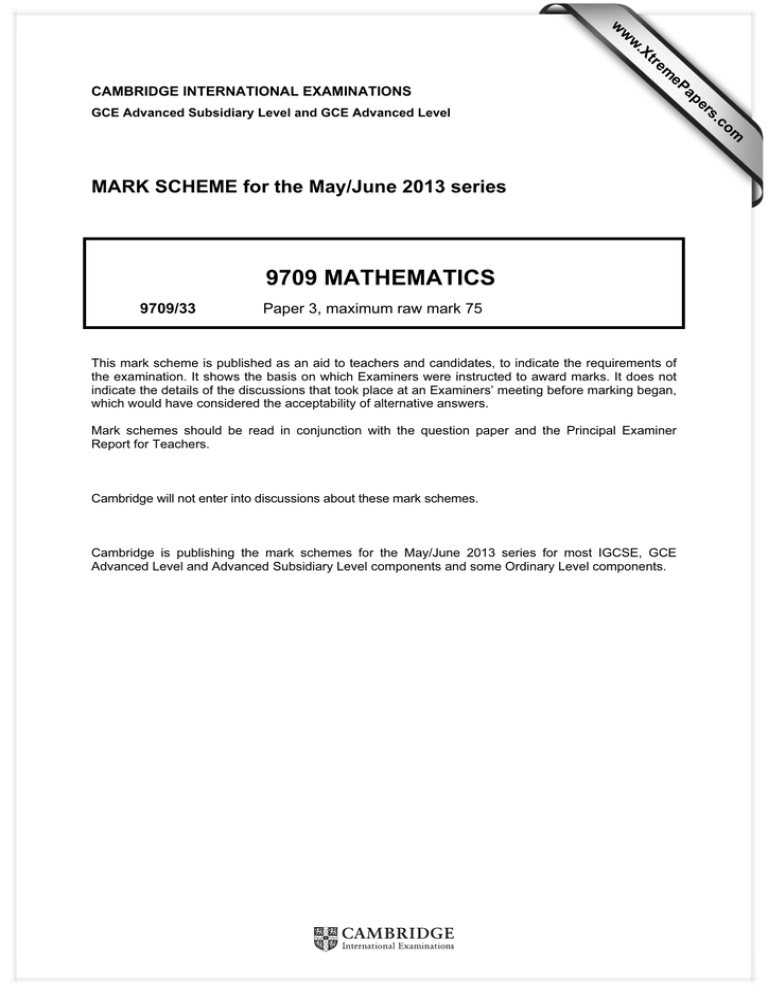
w w ap eP m e tr .X w CAMBRIDGE INTERNATIONAL EXAMINATIONS 9709 MATHEMATICS 9709/33 Paper 3, maximum raw mark 75 This mark scheme is published as an aid to teachers and candidates, to indicate the requirements of the examination. It shows the basis on which Examiners were instructed to award marks. It does not indicate the details of the discussions that took place at an Examiners’ meeting before marking began, which would have considered the acceptability of alternative answers. Mark schemes should be read in conjunction with the question paper and the Principal Examiner Report for Teachers. Cambridge will not enter into discussions about these mark schemes. Cambridge is publishing the mark schemes for the May/June 2013 series for most IGCSE, GCE Advanced Level and Advanced Subsidiary Level components and some Ordinary Level components. om .c MARK SCHEME for the May/June 2013 series s er GCE Advanced Subsidiary Level and GCE Advanced Level Page 2 Mark Scheme GCE AS/A LEVEL – May/June 2013 Syllabus 9709 Paper 33 Mark Scheme Notes Marks are of the following three types: M Method mark, awarded for a valid method applied to the problem. Method marks are not lost for numerical errors, algebraic slips or errors in units. However, it is not usually sufficient for a candidate just to indicate an intention of using some method or just to quote a formula; the formula or idea must be applied to the specific problem in hand, e.g. by substituting the relevant quantities into the formula. Correct application of a formula without the formula being quoted obviously earns the M mark and in some cases an M mark can be implied from a correct answer. A Accuracy mark, awarded for a correct answer or intermediate step correctly obtained. Accuracy marks cannot be given unless the associated method mark is earned (or implied). B Mark for a correct result or statement independent of method marks. • When a part of a question has two or more “method” steps, the M marks are generally independent unless the scheme specifically says otherwise; and similarly when there are several B marks allocated. The notation DM or DB (or dep*) is used to indicate that a particular M or B mark is dependent on an earlier M or B (asterisked) mark in the scheme. When two or more steps are run together by the candidate, the earlier marks are implied and full credit is given. • The symbol implies that the A or B mark indicated is allowed for work correctly following on from previously incorrect results. Otherwise, A or B marks are given for correct work only. A and B marks are not given for fortuitously “correct” answers or results obtained from incorrect working. • Note: B2 or A2 means that the candidate can earn 2 or 0. B2/1/0 means that the candidate can earn anything from 0 to 2. The marks indicated in the scheme may not be subdivided. If there is genuine doubt whether a candidate has earned a mark, allow the candidate the benefit of the doubt. Unless otherwise indicated, marks once gained cannot subsequently be lost, e.g. wrong working following a correct form of answer is ignored. • Wrong or missing units in an answer should not lead to the loss of a mark unless the scheme specifically indicates otherwise. • For a numerical answer, allow the A or B mark if a value is obtained which is correct to 3 s.f., or which would be correct to 3 s.f. if rounded (1 d.p. in the case of an angle). As stated above, an A or B mark is not given if a correct numerical answer arises fortuitously from incorrect working. For Mechanics questions, allow A or B marks for correct answers which arise from taking g equal to 9.8 or 9.81 instead of 10. © Cambridge International Examinations 2013 Page 3 Mark Scheme GCE AS/A LEVEL – May/June 2013 Syllabus 9709 Paper 33 The following abbreviations may be used in a mark scheme or used on the scripts: AEF Any Equivalent Form (of answer is equally acceptable) AG Answer Given on the question paper (so extra checking is needed to ensure that the detailed working leading to the result is valid) BOD Benefit of Doubt (allowed when the validity of a solution may not be absolutely clear) CAO Correct Answer Only (emphasising that no “follow through” from a previous error is allowed) CWO Correct Working Only – often written by a “fortuitous” answer ISW Ignore Subsequent Working MR Misread PA Premature Approximation (resulting in basically correct work that is insufficiently accurate) SOS See Other Solution (the candidate makes a better attempt at the same question) SR Special Ruling (detailing the mark to be given for a specific wrong solution, or a case where some standard marking practice is to be varied in the light of a particular circumstance) Penalties MR –1 A penalty of MR –1 is deducted from A or B marks when the data of a question or part question are genuinely misread and the object and difficulty of the question remain unaltered. In this case all A and B marks then become “follow through ” marks. MR is not applied when the candidate misreads his own figures – this is regarded as an error in accuracy. An MR –2 penalty may be applied in particular cases if agreed at the coordination meeting. PA –1 This is deducted from A or B marks in the case of premature approximation. The PA –1 penalty is usually discussed at the meeting. © Cambridge International Examinations 2013 Page 4 1 Use law for the logarithm of a product, quotient or power Use ln e = 1 or exp(l) = 3 Rearrange as y = (ex3 – 1)–1, or equivalent 4 Paper 33 M1 A1 A1 A1 Obtain critical value x = –1, by solving a linear equation or inequality, or from a graphical method or by inspection B1 3 Obtain the critical value − similarly B2 5 3 State final answer x < –1, x > − B1 5 [Do not condone ≤ or ≥ .] Obtain correct equation free of logarithms in any form, e.g. 3 Syllabus 9709 EITHER: State or imply non-modular inequality (4x + 3)2 > x2, or corresponding equation or pair of equations 4x + 3 = ± x Obtain a critical value, e.g. –1 3 Obtain a second critical value, e.g. − 5 3 State final answer x < –1, x > − 5 OR: 2 Mark Scheme GCE AS/A LEVEL – May/June 2013 [4] M1 M1 y +1 = ex 3 y Use correct tan 2A formula and cot x = 1/tan x to form an equation in tan x Obtain a correct horizontal equation in any form Solve an equation in tan2x for x Obtain answer, e.g. 40.2° Obtain second answer, e.g. 139.8°, and no other in the given interval [Ignore answers outside the given interval.] [Treat answers in radians as a misread and deduct A1 from the marks for the angles.] [SR: For the answer x = 90° give B1 and A1 for one of the other angles.] (i) State R = 2 Use trig formula to find α 1 Obtain α = π with no errors seen 6 (ii) Substitute denominator of integrand and state integral k tan (x – α ) 1 1 State correct indefinite integral tan x − π 4 6 Substitute limits Obtain the given answer correctly © Cambridge International Examinations 2013 A1 A1 [4] M1 A1 M1 A1 A1 [5] B1 M1 A1 [3] M1* A1 M1 (dep*) A1 [4] Page 5 5 6 Mark Scheme GCE AS/A LEVEL – May/June 2013 Syllabus 9709 1 (i) Substitute x = − , or divide by (2x + 1), and obtain a correct equation, e.g. a – 2b + 8 = 0 2 1 Substitute x = and equate to 1, or divide by (2x – 1) and equate constant remainder to 1 2 Obtain a correct equation, e.g. a + 2b + 12 = 0 Solve for a or for b Obtain a = –10 and b = –1 M1 A1 M1 A1 [5] (ii) Divide by 2x2 – 1 and reach a quotient of the form 4x + k Obtain quotient 4x – 5 Obtain remainder 3x – 2 M1 A1 A1 [3] (i) State the correct derivatives 2e2x – 3 and 2/x Equate derivatives and use a law of logarithms on an equation equivalent to ke2x – 3 = m/x Obtain the given result correctly (or work vice versa) B1 M1 A1 [3] 1 (3 − ln a) when a = 1 and a = 2, or equivalent 2 Complete the argument with correct calculated values (ii) Consider the sign of a − 7 Paper 33 B1 M1 A1 (iii) Use the iterative formula correctly at least once Obtain final answer 1.35 Show sufficient iterations to 4 d.p. to justify 1.35 to 2 d.p., or show there is a sign change in the interval (1.345, 1.355) M1 A1 (i) Show that a 2 + b 2 = (a + ib)(a − ib) B1 ∗ Show that (a + ib − ki) = a − ib + ki (ii) Square both sides and express the given equation in terms of z and z ∗ Obtain a correct equation in any form, e.g. (z – 10i)(z* + 10i) = 4(z – 4i)(z* + 4i) Obtain the given equation Either express z − 2i = 4 in terms of z and z* or reduce the given equation to the form z −u = r Obtain the given answer correctly (iii) State that the locus is a circle with centre 2i and radius 5 © Cambridge International Examinations 2013 A1 B1 [2] [3] [2] M1 A1 A1 M1 A1 [5] B1 [1] Page 6 8 Mark Scheme GCE AS/A LEVEL – May/June 2013 Syllabus 9709 Paper 33 (i) Separate variables correctly and integrate at least one side M1 Obtain term ln t, or equivalent B1 Obtain term of the form a ln(k – x3) M1 2 A1 Obtain term − ln(k − x 3 ) , or equivalent 3 EITHER: Evaluate a constant or use limits t = 1, x =1 in a solution containing a ln t and b ln(k – x3) M1* 2 2 3 A1 Obtain correct answer in any form e.g. ln t = − ln(k − x ) + ln(k − 1) 3 3 Use limits t = 4, x =2, and solve for k M1(dep*) Obtain k = 9 A1 OR: Using limits t = 1, x = 1 and t = 4, x = 2 in a solution containing a ln t and b ln (k – x3) obtain an equation in k 2 2 Obtain a correct equation in any form, e.g. ln 4 = − ln(k − 8) + ln(k − 1) 3 3 Solve for k Obtain k = 9 Substitute k = 9 and obtain x = (9 − 8t − M1* A1 M1(dep*) A1 3 1 2 )3 A1 [9] 1 (ii) State that x approaches 9 3 , or equivalent 9 (i) Use product rule Obtain correct derivative in any form, e.g. 4sin2x cos2x cos x – sin2 2x sin x Equate derivative to zero and use a double angle formula Reduce equation to one in a single trig function Obtain a correct equation in any form, e.g. 10 cos3 x = 6 cos x, 4 = 6 tan2 x or 4 = 10 sin2 x Solve and obtain x = 0.685 B1 M1 A1 M1* M1(dep*) (ii) Using du = ± cos x dx, or equivalent, express integral in terms of u and du Obtain ∫ 4u 2 (1 − u 2 ) du , or equivalent Use limits u = 0 and u = 1 in an integral of the form au3 + bu5 8 (or 0.533) Obtain answer 15 10 (i) Equate scalar product of direction vector of l and p to zero Solve for a and obtain a = –6 (ii) Express general point of l correctly in parametric form, e.g. 3i + 2j + k + µ (2i + j + 2k) or (1 – µ )(3i + 2j + k) + µ (i + j – k) Equate at least two pairs of corresponding components of l and the second line and solve for λ or for µ 2 1 2 1 or µ = ; or reach λ (a − 4) = 0 Obtain either λ = or µ = ; or λ = a −1 3 3 a −1 or (1 + µ )(a − 4) = 0 Obtain a = 4 having ensured (if necessary) that all three component equations are satisfied © Cambridge International Examinations 2013 [1] A1 A1 [6] M1 A1 M1 A1 [4] M1 A1 [2] B1 M1 A1 A1 [4] Page 7 Mark Scheme GCE AS/A LEVEL – May/June 2013 Syllabus 9709 Paper 33 (iii) Using the correct process for the moduli, divide scalar product of direction vector if l and normal to p by the product of their moduli and equate to the sine of the given angle, or form an equivalent horizontal equation M1* Use 25 as sine of the angle A1 State equation in any form, e.g. a+6 (a 2 + 4 + 1) (1 + 4 + 4) = 2 5 Solve for a A1 M1 (dep*) 60 Obtain answers for a = 0 and a = , or equivalent 31 [Allow use of the cosine of the angle to score M1M1.] © Cambridge International Examinations 2013 A1 [5]
